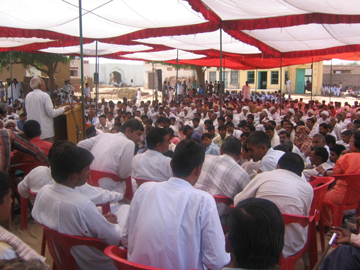
Archive 2009
|
November 1 - 15, 2006 Rajasthan peasants on the warpath Lakhs of peasant men and women, youth and students, have been on the streets of the towns of the region, participating in Mahapadavs (siege) , rasta rokos (highway blockade), village level mahapanchayats (mass rally of peasants of a group of villages) and other forms of protests demanding one thing, that the government of Rajasthan release adequate water— from the two canals from Punjab and Haryana which supply water in these regions— as per agreed upon commitments for the rabi sowing that has begun. The North-Western districts of Rajasthan are desert land with extremely rich soil, needing a few drops of water to turn them into flourishing fields. In the 1960’s, the Indian bourgeoisie built canals in the region to divert excess water from the Sutlej, Ravi and Beas to establish among other things, border security for itself in relation to Pakistan. A powerful peasant agitation in the late sixties/early seventies lead by communist stalwarts ensured that it was the peasants of the region who got the first option on the lands around the canal. The region was soon transformed, through the labour of the peasants, into one of the most agriculturally productive areas of Asia. It will surprise many, that Rajasthan, a desert state, is on the top of agricultural production in a number of areas. For instance, the chana (gram pulses) mandi of Nohar, a tehsil of Hanumangarh district, produces the best and maximum chana in Asia. But in the last decade, the crisis of the peasantry has become grave. Production has fallen to less then 10% of record production. Various reasons, including silting, as well as the policy of successive govts of Rajasthan to keep increasing the canal length to new areas whereas the supply of water has decreased, as well as the decision to divert canal water meant for agriculture to feed industrialization in cities like Jaipur, have pushed the peasants into a corner. As we go the press, the army has been deployed in various towns and villages following clashes between the police and the peasants. In many villages, police patrols have gone to arrest youth, faced the ire of the women folk, and fired on young girls and women. We have received reports of serious injuries to a number of girls and women. Hundreds of our comrades in Nohar, as well as other tehsils in the districts of Hanumangarh, Ganganagar and Bikaner, along with activists of other political parties as well as non party activists, have been forced to go underground, with police issuing arrest warrants against them. Rajasthan’s peasants are organizing themselves into non-partisan Sangharsh Samitis called variously Kisaan Sangharsh Samiti, Kisaan Mazdoor Vyapari Sangharsh Samiti, etc in the different areas. In these non partisan committees, communists from the CGPI, CPI, CPIM, as well as activists of other parties including Congress and BJP are active. We have received reports from all over Rajasthan’s agitating peasantry that the Lok Raj Sangathan, which is working for the empowerment of the people, has been actively organizing the peasants to transform their sangharsh samitis into organs of peoples power. People's Voice condemns the fascist violence deployed by the Rajashtan government against peasants, women and youth agitating for their just claims. PV hails the fighting peasantry, women, youth and students, who are searching for ways and means to establish the rule of the toilers and tillers in our land. |

